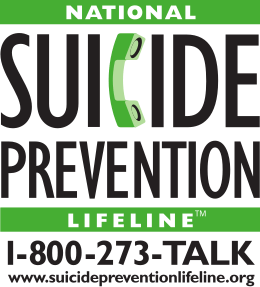Suicide crisis
A suicide crisis, suicidal crisis or potential suicide is a situation in which a person is attempting to kill themself or is seriously contemplating or planning to do so. It is considered by public safety authorities, medical practice, and emergency services to be a medical emergency, requiring immediate suicide intervention and emergency medical treatment. Suicidal presentations occur when there is an emotional problem or predicament that the individual cannot solve and suicide is a solution to them. Clinicians should re-frame suicidal crises, point out that suicide is not a solution and help the individual identify and solve or tolerate the problems.[1]
| Suicide |
|---|
|
Social aspects |
|
Related phenomena |
|
Organizations |
Nature
Most cases of potential suicide have warning signs.[2][3][4] Attempting to kill oneself, talking about or planning suicide, writing a suicide note, talking or thinking frequently about death, exhibiting a death wish by expressing it verbally or by taking potentially deadly risks, or taking steps towards attempting suicide (e.g., obtaining rope and tying it to a ligature point to attempt a hanging or stockpiling pills for an attempted overdose) are all indicators of a suicide crisis. More subtle clues include preparing for death for no apparent reason (such as putting affairs in order, changing a will, etc.), writing goodbye letters, and visiting or calling family members or friends to say farewell. The person may also start giving away previously valued items (because they "no longer need them"). In other cases, the person who seemed depressed and suicidal may become normal or filled with energy or calmness again; these people particularly need to be watched because the return to normalcy could be because they have come to terms with whatever act is next (e.g., a plan to attempt suicide and "escape" from their problems).
Depression is a major causative factor of suicide, and individuals suffering from depression are considered a high-risk group for suicidal behavior. However, suicidal behaviour is not just restricted to patients diagnosed with some form of depression.[5] More than 90% of all suicides are related to a mood disorder, such as bipolar disorder, Depression, or other psychiatric illnesses, such as schizophrenia.[6] The deeper the depression, the greater the risk,[7] often manifested in feelings or expressions of apathy, helplessness, hopelessness, or worthlessness.[8]
Suicide is often committed in response to a cause of depression, such as the cessation of a romantic relationship, serious illness or injury (like the loss of a limb or blindness), the death of a loved one, financial problems or poverty, guilt or fear of getting caught for something the person did, drug abuse, old age, concerns with gender identity, among others.[9]
In 2006, WHO conducted a study on suicide around the world. The results in Canada showed that 80-90% of attempts failed (an estimation, due to the complications of predicting attempted suicide). 90% of failed suicides investigated led to hospitalizations. 12% of attempts were in hospitals.
Treatments

Ketamine has been tested for treatment-resistant bipolar depression, major depressive disorder, and people in a suicidal crisis in emergency rooms, and is being used this way off-label.[10][11] The drug is given by a single intravenous infusion at doses less than those used in anesthesia, and preliminary data have indicated it produces a rapid (within 2 hours) and relatively sustained (about 1–2 weeks long) significant reduction in symptoms in some patients.[12] Initial studies with ketamine have sparked scientific and clinical interest due to its rapid onset,[13] and because it appears to work by blocking NMDA receptors for glutamate, a different mechanism from most modern antidepressants that operate on other targets.[10][14] Some studies have shown that lithium medication can reduce suicidal ideation within 48 hours of administration.
References
- Murray, Declan (2016-02-18). "Is it time to abandon suicide risk assessment?". BJPsych Open. 2 (1): e1–e2. doi:10.1192/bjpo.bp.115.002071. ISSN 2056-4724. PMC 4998936. PMID 27703761.
- Britton PC, Ilgen MA, Rudd MD, Conner KR (2012). "Warning signs for suicide within a week of healthcare contact in Veteran decedents". Psychiatry Res. 200 (2–3): 395–9. doi:10.1016/j.psychres.2012.06.036. PMC 5064427. PMID 22796102.
- thethreeseas.com.au
- health.umd.edu/node/791
- Barker, P. (2003). Psychiatric and Mental Health Nursing The craft of caring. pp 227. New York, NY: Oxford University Press Inc.
- "Suicide and suicidal behavior". MedlinePlus Medical Encyclopedia. 15 January 2009. Retrieved 22 August 2009.
- Stewart, George (2004). "Suicide & Mental Distress". Suicide Reference Library. Archived from the original on 30 September 2007. Retrieved 22 August 2009.
- "Understanding the Symptoms of Depression". WebMD. 12 November 2008. Retrieved 22 August 2009.
- "Suicide". 2 March 2004. Retrieved 22 August 2009.
- Caddy; et al. (Apr 2014). "pharmacodynamic actions, and a systematic review and meta-analysis of efficacy". Ther Adv Psychopharmacol. 4 (2): 75–99. doi:10.1177/2045125313507739. PMC 3952483. PMID 24688759.
- Tondo L; et al. (Feb 2014). "Options for pharmacological treatment of refractory bipolar depression". Curr Psychiatry Rep. 16 (2): 431. doi:10.1007/s11920-013-0431-y. PMID 24425269.
- ECRI Institute, under contract to AHRQ. December 2013 AHRQ Healthcare Horizon Scanning System – Potential High-Impact Interventions Report. Priority Area 05: Depression and Other Mental Health Disorders Archived 2014-08-08 at the Wayback Machine
- National Institute of Mental Health (7 August 2006). "Experimental Medication Kicks Depression in Hours Instead of Weeks". NIH News (Press release). National Institutes of Health; Dept. of Health and Human Services; United States.
National Institute of Mental Health director Thomas Insel said, "To my knowledge, this is the first report of any medication or other treatment that results in such a pronounced, rapid, prolonged response with a single dose. These were very treatment-resistant patients."
- Naughton, M; Clarke, G; O'Leary, OF; Cryan, JF; Dinan, TG (Mar 2014). "A review of ketamine in affective disorders: current evidence of clinical efficacy, limitations of use and pre-clinical evidence on proposed mechanisms of action". Journal of Affective Disorders. 156: 24–35. doi:10.1016/j.jad.2013.11.014. PMID 24388038.